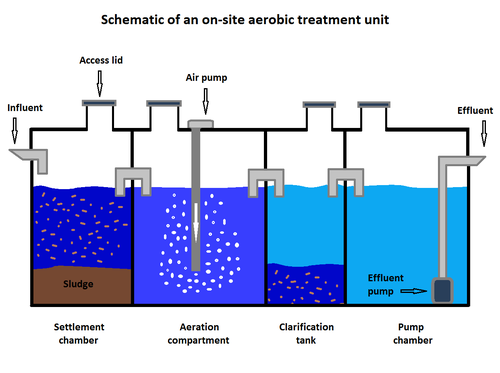An aerated treatment unit consists of a tank similar to a septic tank. The tank is partitioned into four compartments. The first compartment receives the wastewater and acts as a sedimentation tank for solids. The overflow from the first compartment goes to an aeration compartment. The aeration compartment is fitted with corrugated plastic sheets to enable bacteria to attach themselves. The aeration supplies oxygen to the bacteria decomposing the organic matter in the wastewater thus reducing its BOD. After aeration, the wastewater passes to a third compartment, which acts as a second sedimentation tank. Sludge from this second sedimentation tank is pumped to the first compartment for storage. After sedimentation, the wastewater overflows to a fourth compartment for storage and pumping, usually for irrigation of garden beds. If required, chlorine is applied by inserting chlorine tablets in the pipe between the third and fourth compartments. Chlorination is required when sprinklers irrigate the treated wastewater. Sub-surface irrigation is preferred, because it does not require chlorination. Power is required for aeration and pumping. This on-site unit is a miniature of the primary and secondary stage treatment of an off-site treatment plant. One difference is that surfaces are provided in the aeration tank to retain bacteria during peak flows. The other difference is that sludge from the second sedimentation tank is returned to first tank for storage. (UNEP 2000)
